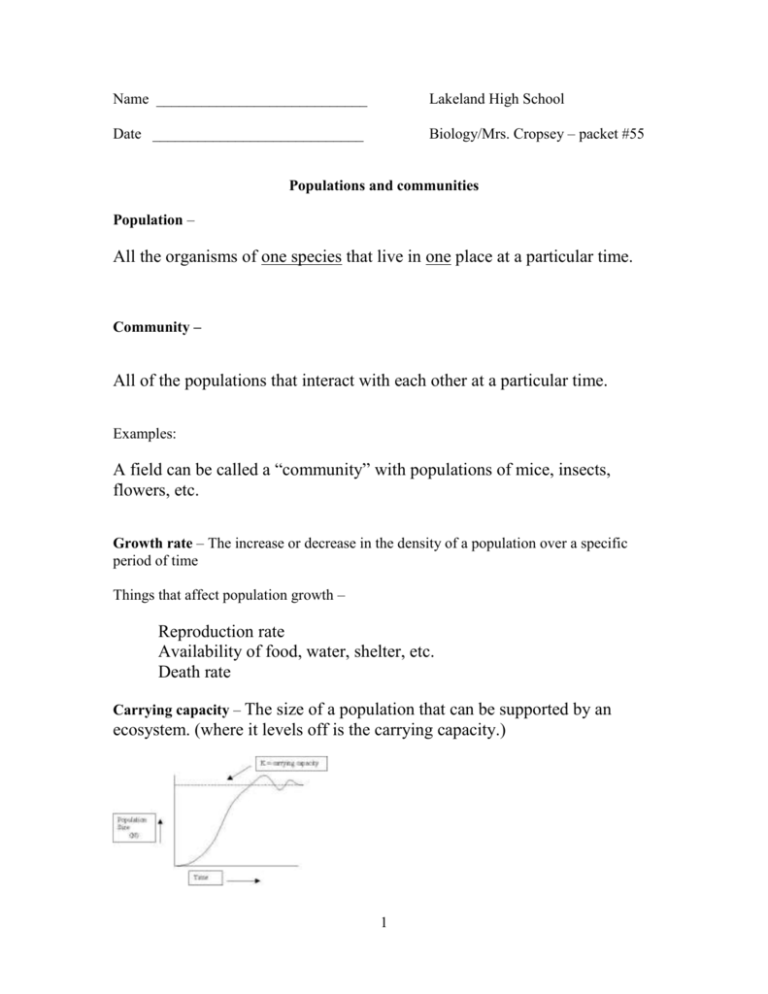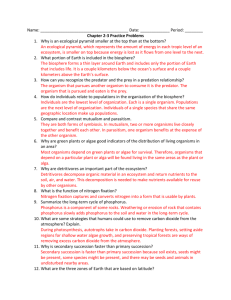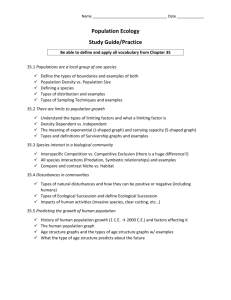Populations and communities
advertisement

Name ____________________________ Lakeland High School Date ____________________________ Biology/Mrs. Cropsey – packet #55 Populations and communities Population – All the organisms of one species that live in one place at a particular time. Community – All of the populations that interact with each other at a particular time. Examples: A field can be called a “community” with populations of mice, insects, flowers, etc. Growth rate – The increase or decrease in the density of a population over a specific period of time Things that affect population growth – Reproduction rate Availability of food, water, shelter, etc. Death rate Carrying capacity – The size of a population that can be supported by an ecosystem. (where it levels off is the carrying capacity.) 1 Community interactions No organism lives alone – no population lives alone. Organisms that live in the same environment are always interacting with each other. Competition is one of the main interactions between organisms. Competition can be interspecific, meaning two different species competing for the same resources (food, shelter, etc.) or intraspecific, meaning between members of the same species. Both types of competition result in only the most fit individuals surviving and passing on their genes What is this process called, where only the most fit individuals survive? Natural selection. Survival of the fittest Predation is another basic relationship that occurs in nature Prey An organism that is hunted or seized for food Predator- An organism that lives by preying on other organism An organism can be both in a food chain Over time, certain species have evolved certain adaptations to help them avoid becoming prey Mimicry - An organism pretends to be something else 2 Camouflage – An organism is difficult to see because it blends in with its environment. Why is this beneficial ? ---hide from predators Symbiosis – One type of organism lives near or in another organism The organism can either help, harm or have no effect on the other Parasitism One organism is helped, the other is hurt Parasite / host Commensalism One organism is helped – the other is neither harmed nor helped 3 Mutualism - Both organisms benefit Changing communities – succession Succession – the orderly change in the inhabitants of an area through time Pioneer community- First plants in an are – usually lichens, algae Climax community Everything in balance – stability is reached No changes in the community 4 Primary succession Occurs in areas where there was no life before Secondary succession Succession in areas where there was life before Example: a forest fire destroys a forest The forest will eventually rebuild following secondary succession 5 Summary Questions 1. What is the difference between a population and a community? 2. What are some factors that would influence the rate of population growth? 3. How would a population’s growth rate be affected once it reaches carrying capacity? 4. Why are mimicry and camouflage use adaptations in nature? 5. Fleas live on a dog and drink its blood, causing itchy bites that make the dog miserable. This is an example of what type of relationship? 6 6. Many corals have algae that live inside their tissues. The algae are protected by the coral, and the coral need the algae to survive. This is an example of what type of relationship? 7. The regrowth of an environment after a fire would be considered which type of succession? 7








